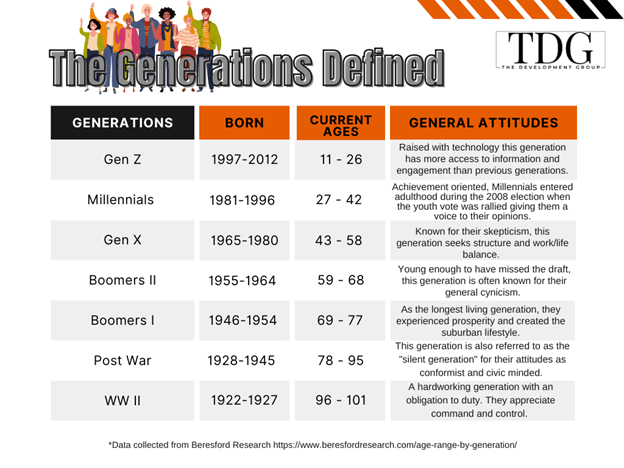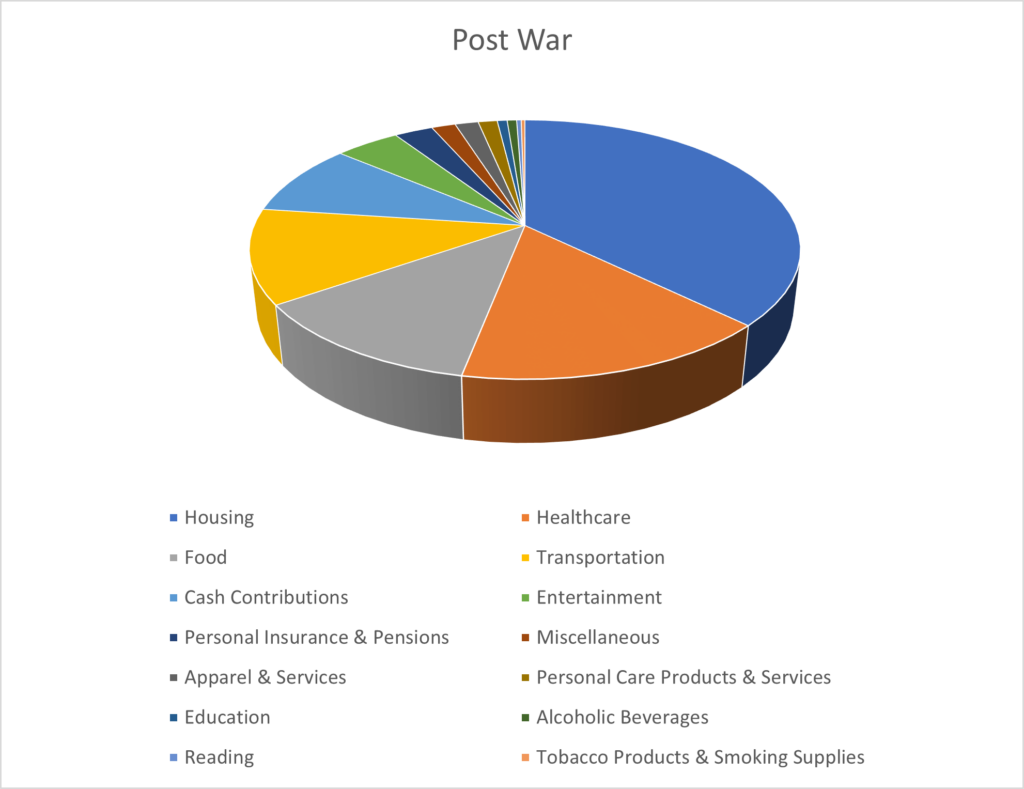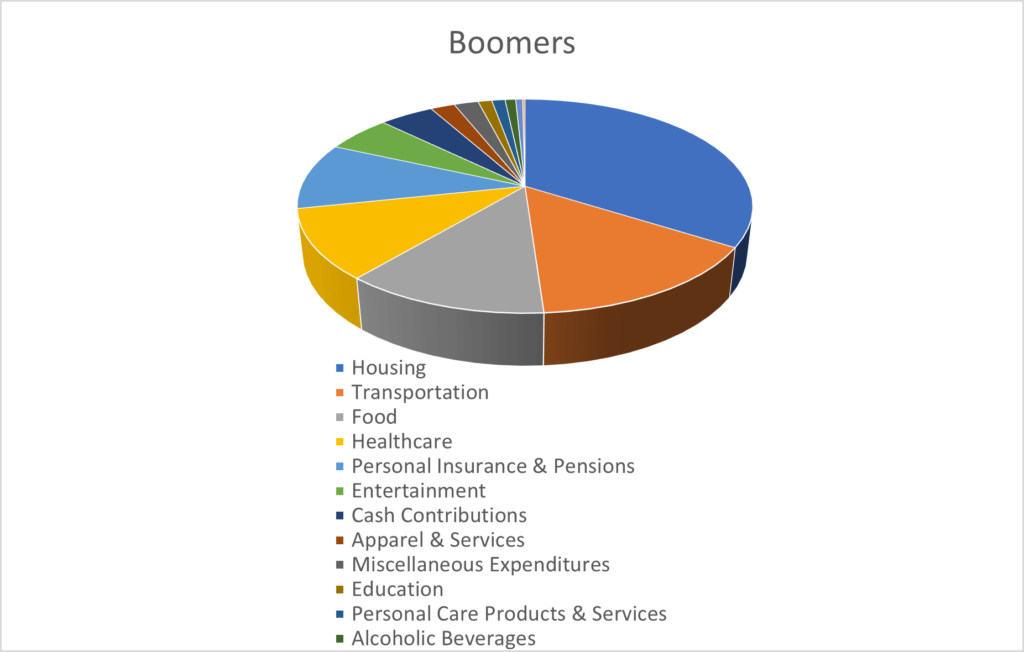How community and business leaders can make decisions based on generational grouping.
Pew Research Center credits an individual’s age as the most common predictor of differences in attitudes and behaviors. A person’s age references their place in the life cycle and their belonging in a cohort of individuals with a shared value based on expectations and experiences shaped by society.
Generations are a common research tool to group age cohorts. Yet, generations have become an identification factor that has outgrown traditional research. Generational grouping has become a fire that is fanned by social media and nomenclatures. Creating a following that is placing opinions, attitudes, and behaviors at the culmination of a culture. Will this growing acceptance of generational identities create a more polarizing future? Perhaps. Will it link an entire generation and spur social change? Absolutely possible.

Generational Impacts on the Economy
Without a doubt, generational differences shape the economy through workforce, spending, and politics. Economic development professionals and community leaders can adjust their practices to target specific generations and predict the economic needs of the future.
Workforce
Workplace expectations vary between generations and become evident in the workforce’s values. Purdue Global notes that there are five generations in the workplace for the first time in history (six if you maintain the divided baby boomer generations).
Generation X, Millennials and Generation Z, together account for 73% of the current workforce. These younger generations prioritize a work-life balance and are more willing to leave an organization than their older counterparts.
The post- war generation makes up 2% of today’s workforce. Their straightforward, dependable and loyal characteristics are derived from their obedience over individualism worldview. Motivated by respect and recognition, employers can use personal touch and handwritten notes to encourage employees of the post-war generation.
10,000 Baby Boomers reach retirement age every day. However, 65% of the generation plans to work past the age of 65. Known as the “workaholics” of the workforce, Baby Boomers demonstrate company loyalty and hold the belief that sacrifice is necessary for success. Dr. Bea Bourne, DM, faculty member in the School of Business and Information Technology at Purdue Global encourages employers to provide Baby Boomers with specific goals and deadlines to achieve maximum results. This generation responds well to being elevated to mentor roles and being provided coaching-style feedback.
Flexible, skeptical and independent, Generation X is resistant to change at work if it affects their personal lives. Their communication style reflects their later, yet formidable, exposure to technology. Generation X marks the middle of the road between earlier and later generations. They prefer whatever communication style is most efficient, including phone calls and face to face. Generation X makes up the largest percentage of startup founders as they are motivated by their personal-professional interests over their employer/company’s interests.
Millennials are known to be the competitive, achievement-oriented generation of the workforce. Responsibility, quality of their manager and unique work experiences motivate this generation. Millennials value challenges, growth, and development just as much as a fun work life. Their perception of the quality of their manager will have the greatest impact on their work.
Finally, Generation Z has been dubbed the least focused of the workforce. Offering opportunities to work on multiple projects at the same time meets their need, which was arguably created by their exposure to technology. This generation is progressive and independent, preferring to be self-directed with minimal interactions with their superiors. Their creativity and individuality make them an asset to the team.
With diverse strengths, having a historical number of generations in a single workforce should create more robust work product. However, with such varying core values employers must be flexible in managing. Standard blanket expectations and management practices will not result in the most productive work environment.
Spending
As unique as each worldview, generational groups have spending habits that allows economist to differentiate between each generation. The World Economic Forum has studied how Americans spend their money and identified patterns within generations.
Currently, Generation X has the largest Average Annual Expenditure at $83,357 with Millennials following at $69,061, Boomers at $62,203, Post War at $44,683 and finally our youngest generation Gen. Z at $41,636. Breaking spending habits into 14 categories, how the generations spend their income is illustrated in the graphs below:





Before diving into the differences of spending, we will first explore the similarities. Each generation spends the most amount of money on housing. The entertainment category falls as the 6th highest expenditure. Just like in the workplace, Generation X, Millennials, and Generation Z are the most common in their spending habits. The younger the generation, the lower healthcare spending ranks. Contrasting, the older the generation the lower education ranks.
Generation X and Millennials invest more into personal insurance and pensions and less on food than any other generations. As can be expected based on their stage of life, Generation Z spends the most on education when compared to the other generations. Millennials match Generation Z on their spending for apparel and services. Boomers spend more on food than any other generation.
Knowing how each generation prioritizes expenditures allows leaders to determine what their community should look like to attract the intended generation. Spending is a true reflection of priorities and allows researchers to track habits and plan intentionally.
Politics
The polarizing political divide is often casted into the shadows of republicans and democrats. Generational beliefs may be the leading culprit of the differing attitudes and values. Millennials and Gen X lean toward a liberal political view. The racial and ethnic diversity of younger generations may be a leading factor. Millennials are more than 40% non-white and 65% of Millennials disapprove of Trump’s presidency.
Contrasting the younger generations, Post War and Boomers express higher approval of Trump’s presidency. As the generations age, they continue to vote more along the republican lines. These political values are consistent in issues such as immigration, same-sex marriage, and opinions about America’s relative standing in the world.
It is notable that generations differ on most political values. However, they all share a sentiment of distrust towards the federal government. It is important for community leaders to be aware of an innate skepticism toward government and officials. Creating a practice of transparency and a narrative of accountability and community involvement will be necessary to move initiatives forward.
What Does this Mean for Economic Developers and Community Leaders?
Without creative ingenuity, generational differences and values may be viewed as an obstacle. As economic developers, these generational attitudes and values can be valuable in determining resources and projects that will attract the desired demographics. Knowing how each generation spends money, selects a workplace and how they vote will allow community leaders to make decisions that attract particular generations. It also gives decision makers the knowledge and ability to smooth the gaps between differing values.
References
World Economic Forum: How do different generations in the US spend their income? | World Economic Forum (weforum.org)
Purdue Global: Generational Differences in the Workplace [Infographic] (purdueglobal.edu)
Pew Research: The Whys and Hows of Generations Research | Pew Research Center
